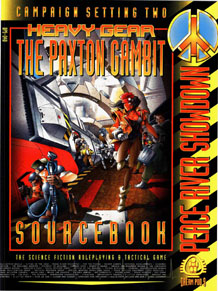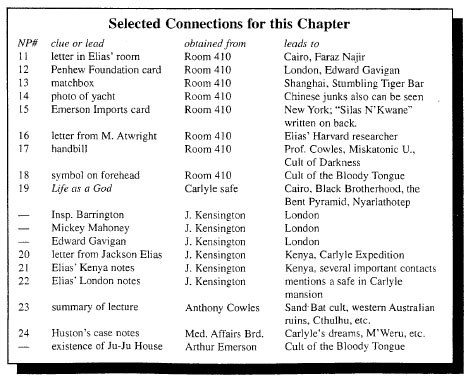As discussed previously, this was the first review I posted to RPGNet. It was originally written for the Heavy Gear Mailing List and then reposted to RPGNet when Dream Pod 9 requested that HGML posters report their reviews at the site.
This, of course, also means that this is some of the earliest writing I ever did for a semi-professional audience. Be gentle in your judgments.
 [ Warning: This review will contain spoilers of the adventure series contained in this product. If you are intending to play through the story told in this product you should stop reading now. ]
[ Warning: This review will contain spoilers of the adventure series contained in this product. If you are intending to play through the story told in this product you should stop reading now. ]
The Paxton Gambit, unsurprisingly, is another sterling DP9 product for their Heavy Gear line. The first 25 pages expand upon the information given on Peace River previously (in Into the Badlands and the Second Edition Heavy Gear rulebook). The next 32 pages are a campaign supplement, and the remaining 6 are Paxton Gear designs.
Peace River has been covered previously, so what’s there in terms of background is pretty scarce — you get some new info on the political situation as of 1935, details of the Badlands Quarter, some detailed maps, an overview of the POC structure, and a number of new NPCs (all of which are important in the campaign portion of the book).
The Paxton Gear designs are … well, they’re Gears. What do you want?
The campaign supplement is, however, the book’s strength, in my opinion. You get 27 pages of story material stretching over nearly 20 days and nine gaming sessions (your mileage may vary, of course). You also get a page of “Continuing Hooks” which tell you where to go next if you want to continue the campaign, and four pages of handouts for the players.
The main section of the campaign is separated into three acts, each containing three scenarios. Each scenario consists of “Milestones”, which detail each important scene or sequence for the players to engage in. They also contain “Complications and Continuing Hooks” — little extras unessential to the main plot, but which can be thrown in to add complexity to the sessions themselves or cause headaches down the line for the players.
The plot of the campaign is thus (these are the spoilers):
In the wake of the Oxford Agreement (see CoF) Emir Shirow of Basal can no longer rely on the CNCS or NLC to supply him with arms in his rebellion, leaving him with only one serious option: Paxton Arms. He dispatches his lover and ambassador Victorya Hiro to Peace River to negotiate the deal. However, he doesn’t have enough money to fund the project completely. Therefore, Hiro will also be secretly negotiating with the NLC in order to get the money to make the deal with Paxton Arms. Jacques Molay will be dispatching SRID operatives to break up the deal because he doesn’t like the Basal rebellion for personal reasons, but this also means that these operatives have a chance of uncovering the NLC deal, which will break the Oxford Agreement and bring down the SR’s wrath on Shirow. Added to this is the fact that the SRID typically deals with the Forzi in Peace River for this type of low-profile work, but the Forzi in Peace River are actually controlled by the BRF’s local leader Sund! ra Gabriel, and she would like nothing better than to screw this deal up herself and make things tough on Paxton Arms. And, of course, the Patriarch of the ESE has gotten wind of the deal and dispatched agents to eliminate the Basal forces involved in the deal. This is the point where the players enter.
The campaign is designed so that, with a minimal amount of work, the GM can sit down with his players and start playing. Indeed, if you’re particularly effective at off-the-cuff playing you could probably run the thing untouched once you’ve got the material down and copies made of the hand-outs. The scenario is also designed, however, to allow existing campaigns to intersect with the story with a bit more work involved. Clearly you can see with all these different groups coming together over one deal (CNCS and NLC, SRID, BRF, Paxton/Peace River security and executives, Basal Uprising, ESE, etc.) there are a multitude of different ways for a GM to get his players involved in the events of this story. But the campaign is designed around the idea that players will be assuming the roles of Peace Officers.
They are introduced into the action as honor guards to the arrival of the Basalite ambassadors, and are put under the temporary command of Colonel Lenaris. They are also introduced at this point to Helen Luka, a reporter in search of the big scoop. The next day they are put on surveillance of a group arriving on a cargo maglev line — clearly undercover. These are the NLC negotiators arriving.
>From this point on in they are drawn into a dizzying array of political events and placed under the direct command of Lenaris as they become the only agents he can trust in this matter. Early on in the campaign they eliminate the Patriarch’s force in Peace River and think they’re doing pretty well, until the depths of the BRF and SRID involvement is revealed.
By the time the dust clears it is fully possible for the players to have been instrumental in completely destroying the SRID and BRF presence in Basal, Sundra Gabriel will be dead, they will have saved all Peace River from a reactor meltdown, the deal will have gone off perfectly, and they will be trusted agents of both Lenaris and HEO DuBeau-Slovenski.
So are where are the weaknesses? Well, one of them is Helen Luka. She hangs around the players like a faithful dog during the first act, and then abruptly disappears from the campaign entirely. Considering she’s given a full page write-up I would expect her to be of slightly more importance in the campaign. Also odd is the complete lock-down on any communication or travel in or out of Peace River for nearly 24 hours during the course of the adventure. While I have no doubt — PR being an arcology and all — that this would be possible, the repercussions on a major export economy of this happening are never mentioned (not even in the “Continuing Hooks” section) in the book.
The latter is, perhaps, a matter of selective blindness and saying that the resolution “takes place off-stage”. The former is a major plot oversight, in my opinion, and should be resolved by any GM considering running this campaign.
However, despite those reservations I would say that the story is a strong one, and I think all GMs should consider picking the book up if their players would have any chance of intersecting with the events detailed therein, it will be well worth your while. It is also a good example of how to tie players into the larger events of Terra Nova without disrupting the main flow of the primary storyline (if you ignore the complete rout of BRF forces in Peace River, which is clearly a major plot point in the continuing saga of Terra Nova — the adventure could just as easily be completed without this type of major conclusion).
Style: 5 (Excellent!)
Substance: 4 (Meaty)
Author: Michael Butler and Guy-Francis Vella
Category: game
Company/Publisher: Dream Pod 9
Cost: $15.95
Page count: 64
ISBN: 1-896776-33-7
Originally Posted: 04/17/98.
 Greg Stolze’s Reign features a simple Wealth system. Characters, treasures, and resources are given Wealth ratings and all of these ratings are interchangeable. (A Wealth 3 treasure has as much value as a character with Wealth 3.)
Greg Stolze’s Reign features a simple Wealth system. Characters, treasures, and resources are given Wealth ratings and all of these ratings are interchangeable. (A Wealth 3 treasure has as much value as a character with Wealth 3.)













